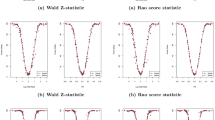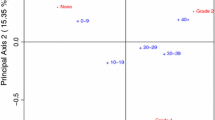Abstract
The problem of association between two attributes in ap×q contingency table can be looked upon as the problem of relationship between two vector variablesx andy. If there is only one true non-zero canonical correlation betweenx andy, the association between the two attributes is of rank 1 and in this case, one set of scores is adequate to describe the association completely; these scores are nothing but the coefficients in the canonical variates corresponding to the true non-zero canonical correlation. Given a set of hypothetical scoresα 1,α1,⋯,αp for the rows, one is interested in testing their goodness of fit. Tests for this are suggested in this paper. For obtaining these tests, a preliminary result about direction and collinearity factors in discriminant analysis, whenS irrelevant variables are eliminated, is needed. This is derived in part one of this paper.
Similar content being viewed by others
References
Bartlett, M. S. (1951). The goodness of fit of a single hypothetical discriminant function in the case of several groups,Ann. Eugen.,16, 199.
Fisher, R. A. (1940). The precision of discriminant functions,Ann. Eugen.,10, 422.
Fisher, R. A. (1950).Statistical Methods for Research Workers, 11th ed., Edinburgh, Oliver and Boyd.
Kshirsagar, A. M. (1964). Distribution of the direction and collinearity factors in discriminant analysis,Proc. Camb. Philos. Soc.,60, 217.
Kshirsagar, A. M. (1969). Correlation between two vector variables,Jour. Roy. Statist. Soc., B31, 477–485.
Muang, K. (1941). Measurement of associations in a contingency table with special reference to the pigmentation of hair and eye colour of Scottish school children,Ann. Eugen.,11 189.
Pillai, K. C. S. (1955). Some new test criteria in multivariate analysis,Ann. Math. Statist.,26, 117.
Rao, C. Radhakrishna (1962). A note on a generalized universe of a matrix with applications to problems in mathematical statistics,Journ. Roy. Statist. Soc., B,24, 152–158.
Wilks, S. S. (1932). Certain generalizations in the analysis of variance,Biometrika,24, 471.
Williams, E. J. (1952). Use of scores for the analysis of association in contingency tables,Biometrika,39, 274.
Williams, E. J. (1955). Significance tests for discriminant functions and linear functional relationships,Biometrika,42, 360.
Williams, E. J. (1967). The analysis of association among many variates,Jour. Roy. Statist. Soc., B,29, 199.
Yates, F. (1948). The analysis of contingency tables with groupings based on quantitative characters,Biometrika,35, 176.
Author information
Authors and Affiliations
Additional information
This research was sponsored by the Office of Naval Research, Contract No. N00014-68-A-0515, Project No. NR042-260. Reproduction in whole or in part is permitted for any purpose of the United States Government.
About this article
Cite this article
Kshirsagar, A.M. Goodness of fit of an assigned set of scores for the analysis of association in a contingency table. Ann Inst Stat Math 22, 295–306 (1970). https://doi.org/10.1007/BF02506345
Received:
Issue Date:
DOI: https://doi.org/10.1007/BF02506345




